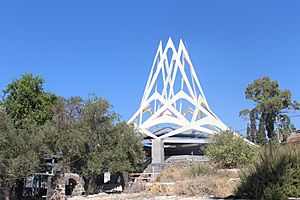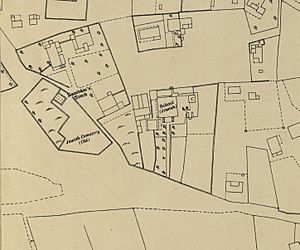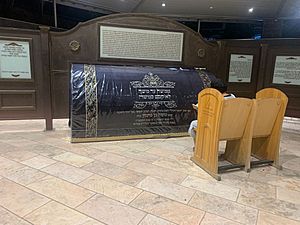Tomb of Maimonides facts for kids
The Tomb of Maimonides (Hebrew: קבר הרמב"ם, romanized: Kever ha-Rambam) is a very important Jewish burial site. It is located in Tiberias, a city on the western shore of the Sea of Galilee in Israel.
Maimonides was a famous Jewish scholar and doctor. He passed away in Fustat, Egypt, on December 12, 1204. People believe he was first buried there for a short time. Later, his body was moved and reburied in Tiberias.
The Tomb of Maimonides is one of the most important places for Jewish pilgrimage in Israel. Many people visit it every year. It is also a popular tourist spot in Tiberias. Other important rabbis are also buried near Maimonides. These include Rabbis Yochanan ben Zakai and Isaiah Horowitz.
Contents
Interesting Stories and Legends
Many interesting stories are told about how Maimonides was buried.
The Bedouin Guards
One story says that after Maimonides died, his bones were kept for a week in a small shrine. This was a place where he used to study and help sick people for free. Some people believe his bones never left Egypt. Others believe his final resting place was always meant to be in Tiberias.
A legend tells of a group of Bedouins who were planning to attack his funeral procession. This was as it traveled through the desert. But when they realized it was the funeral of the man who had helped them and their families for free, they felt ashamed. Instead of attacking, they formed a protective guard. They helped the procession safely reach Israel.
The Forgotten Toe
Another story was told by Joseph ben Isaac Sambari. He was a Jewish writer from Egypt in the 1600s. He wrote about an old story that people used to tell.
This story says that the people carrying Maimonides' body to the Sea of Galilee accidentally left one of his toes behind. It was left in the Maimonides synagogue. Later, one of the people who carried the body had a dream. A wise man from Egypt reminded him about the forgotten toe. The toe was found and buried next to Maimonides' body.
The Tomb's Location in Tiberias
The first written record saying Maimonides was buried in Tiberias comes from a writer named Al-Qifti. Many other old writings from the 1200s to 1400s agree with this.
A writer named Samuel Shullam was the first to express some doubt. He wrote, "He was buried in Tiberias, or, as some say, he was buried with the Patriarchs in Hebron." Most modern experts agree that Maimonides was buried in Tiberias. However, a scholar named Armand Kaminka believed his body never left Egypt.
In 1920, Rabbi Ya'akov Moshe Toledano bought the land around the tomb. This made the tomb officially owned by Jewish people.
Protecting the Graves
In late 1955, the Religious Services Minister of Israel started digging around the tomb. They soon found many more graves near Maimonides' tomb. Even with these discoveries, the Department of National Roads Company of Israel continued their work.
The government's actions of disturbing known graves upset religious Jewish communities. People from Neturei Karta and Bnei Brak volunteered to protect the graves. They worked in shifts to stop government workers and archaeologists from getting too close. They also held protests in Tiberias to show people what was happening.
At one point, a government tractor working at the site hit the nearby grave of Isaiah Horowitz. The volunteers made the tractor driver leave. Because of this incident, the government had to stop all work at Maimonides' tomb site. Representatives from the Religious Services Minister and the Chief Rabbinate of Israel promised that no more digging would happen there.
A Symbol of Respect
Later, a large metal structure was built over the tomb area. It looks like a crown. This crown shows the great respect that Maimonides holds in Jewish tradition.
See also
 In Spanish: Tumba de Maimónides para niños
In Spanish: Tumba de Maimónides para niños




